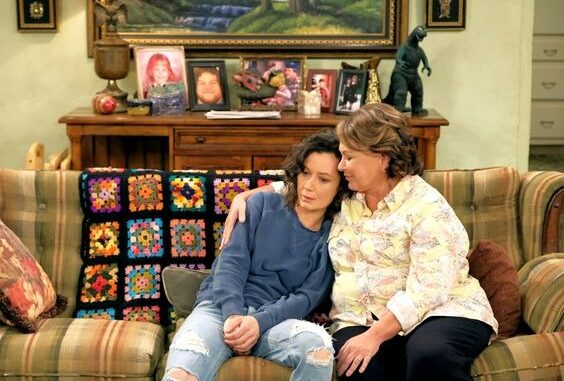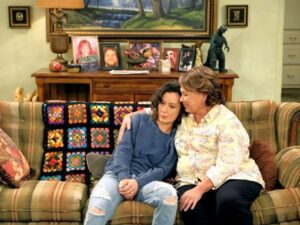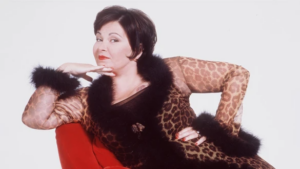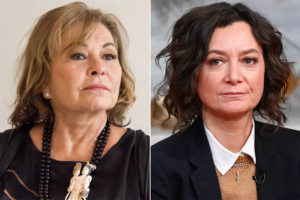
Sara Gilbert’s Darlene wasn’t gay, but she became an icon to the LGBTQ community.
Image may contain Furniture Couch Human Person Cushion Living Room Room Indoors and Shelf
Darlene Conner wasn’t queer, but for the subset of the show’s audience that was—myself included—she felt like one of us.ADAM ROSE

THERE WAS JUST something about her. Maybe it was the plaid flannels. Or the Doc Martens. Or her frequent indifference to her boyfriend, David. Whatever it was, something about Darlene spoke to queer women. For nine seasons, the character played by Sara Gilbert on ABC’s Roseanne was, however subtly, a role model for people who looked at her and saw something of themselves. Darlene wasn’t queer, but for the subset of the show’s audience that was—myself included—she felt like one of us.
Gilbert’s character wasn’t the first, and she wouldn’t be the last. Before Roseanne, it was Jo on Facts of Life. A few years after, Rayanne Graff on My So-Called Life caught my eye. (Was I alone there? I dunno.) Then it was Ellen DeGeneres on her eponymous ABC show—though she would later actually come out as a lesbian, breaking down barriers and making room for everyone from the gays of Will & Grace to the riding, winning, losing, cheatin’, kissing, thinking, dreaming women of The L Word.
But before them, and definitely before the it’s-hip-to-be-queer characters of Riverdale and Runaways, LGBTQ kids didn’t have many folks on TV or in movies to model themselves after. So they adopted the closest approximations they could find. An informal poll of my queer friends pulled up suggestions ranging from Lucy Lawless’s character on Xena: Warrior Princess and Sherlock (and Watson) to Spinelli on Recess and Batman (and Robin). Other suggestions: Icebox in Little Giants; Raven from That’s So Raven; Punky Brewster; Angelica from Rugrats; Khadijah from Living Single (OK, that one was mine); and “whatever Olsen twin wore the baseball cap in It Takes Two.” The list could go on, but the idea is the same: people who don’t often get represented in media tend to attach themselves to someone that’s close enough.
In his book The Prime Time Closet: A History of Gays and Lesbians on TV, Stephen Tropiano calls these “gay-straight” characters, people who may seem queer but are presented as straight. He traces their origins to a time before TV was comfortable with LGBTQ people—or only comfortable with them as the subject of jokes. “There were no gay men or lesbians living next door to the Ricardos and the Kramdens or waiting to be rescued on Gilligan’s Island,” Tropiano writes. “Gay, lesbian, bisexual, and transgender characters didn’t appear in situation comedies until the early 1970s. Around the same time, sitcoms began to devote single-episode story lines to mature subjects and themes, such as racism, alcoholism, abortion, anti-Semitism, and homosexuality. Before sitcoms like All in the Family, Barney Miller, and Maude hit the airwaves, gay viewers had to settle for shows exhibiting a certain ‘gay appeal.’”

Ah, settling. The least favorite pastime of underrepresented groups for decades. It’s unfortunate, but identifying with characters who weren’t quite representing them has been queer people’s lot for generations. (This becomes especially hard for transgender people and queer people of color, who have had even fewer characters to look to.) And for a long time, popular media got away with it. A show like Murphy Brown or The Dick Van Dyke Show could have gay-but-not characters whom queer audiences could see themselves in if they squinted enough, but who never actually had to be gay, let alone saying they were. It wasn’t equitable, but that’s just the way it was.
As times changed, particularly throughout the 1990s, LGBTQ characters started showing up more and more. Willow came out on Buffy the Vampire Slayer. Viewers with premium cable got Queer as Folk. But another pattern emerged: queerbaiting. Shows like Xena or even Rizzoli & Isles have come under fire for using subtle nods to keep queer viewers interested, but never committing to queer characters. (And really, even with the constant influx of queer characters onto TV, representation is still not overwhelming. A recent GLAAD report found that while the number of LGBTQ characters was the highest the organization had ever found, it was still only 43 characters out of 895 series regulars—less than 5 percent.)

This wasn’t the case with Roseanne. During its nearly decade-long run, the show had several queer characters, Roseanne (Roseanne Barr) herself kissed a woman on-air in a 1994 episode, and it had one of the first-ever gay weddings on primetime a year later when Leon (Martin Mull) married Scott (Fred Willard). Darlene, if anything, was largely the embodiment of a certain kind of tomboyishness that was prevalent in the 1990s. And what queer fans might have been attaching to back then was Gilbert herself, who came out in 2010. (She’s now married to 4 Non Blondes frontwoman Linda Perry, if you want to know what’s goin’ on.) Moreover, she and her castmates have even acknowledged her character’s queer icon past: John Goodman (aka Dan Conner) appeared in character on her daytime show, The Talk, for a segment wherein she said, “There’s something I’ve been wanting to talk to you about for a while now” before confessing that she was a talk show host. When he responded, “I thought you were going to tell me you were gay,” she simply responded, “Let’s save something for halftime.”
And Roseanne appears to be nodding to Darlene’s legacy with its new season. When the show comes back tonight, its new characters include Mark (Ames McNamara), Darlene’s 9-year-old son who often wears skirts, glitter, and boots with fringe. The Conners worry about his safety at school, but support his style regardless. In a telling exchange between Dan, Roseanne, and their daughter, Darlene notes that her father had no issue with her wearing “basketball shorts and a Bulls jersey to school every day.” When Roseanne retorts that the family isn’t bigoted because they’ve “already came to terms with the fact that you were gay” her daughter quickly responds “I’m not gay!” It gets a laugh, only this time everyone—Gilbert, the studio audience, and the LGBTQ community at large—is in on the joke. Darlene may not have been queer, but for those who looked up to her, she was family.
